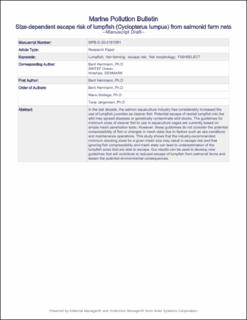| dc.contributor.author | Herrmann, Bent | |
| dc.contributor.author | Sistiaga, Manu | |
| dc.contributor.author | Jørgensen, Terje | |
| dc.date.accessioned | 2020-12-15T11:57:08Z | |
| dc.date.available | 2020-12-15T11:57:08Z | |
| dc.date.created | 2020-12-14T10:13:06Z | |
| dc.date.issued | 2020 | |
| dc.identifier.citation | Marine Pollution Bulletin. 2020, 162 . | |
| dc.identifier.issn | 0025-326X | |
| dc.identifier.uri | https://hdl.handle.net/11250/2719531 | |
| dc.description.abstract | In the last decade, the salmon aquaculture industry has considerably increased the use of lumpfish juveniles as cleaner fish. Potential escape of reared lumpfish into the wild may spread diseases or genetically contaminate wild stocks. The guidelines for minimum sizes of cleaner fish to use in aquaculture cages are currently based on simple mesh penetration tests. However, these guidelines do not consider the potential compressibility of fish or changes in mesh state due to factors such as sea conditions and maintenance operations. This study shows that the industry-recommended minimum stocking sizes for a given mesh size may result in escape risk and that ignoring fish compressibility and mesh state can lead to underestimation of the lumpfish sizes that are able to escape. Our results can be used to develop new guidelines that will contribute to reduced escape of lumpfish from salmonid farms and lessen the potential environmental consequences. | |
| dc.language.iso | eng | |
| dc.title | Size-dependent escape risk of lumpfish (Cyclopterus lumpus) from salmonid farm nets | |
| dc.type | Peer reviewed | |
| dc.type | Journal article | |
| dc.description.version | acceptedVersion | |
| dc.source.pagenumber | 11 | |
| dc.source.volume | 162 | |
| dc.source.journal | Marine Pollution Bulletin | |
| dc.identifier.doi | https://doi.org/10.1016/j.marpolbul.2020.111904 | |
| dc.identifier.cristin | 1859368 | |
| cristin.ispublished | true | |
| cristin.fulltext | postprint | |
| cristin.qualitycode | 1 | |
